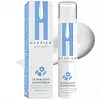What's inside
What's inside
 Key Ingredients
Key Ingredients

 Benefits
Benefits

 Concerns
Concerns

 Ingredients Side-by-side
Ingredients Side-by-side

Water
Skin ConditioningEthylhexyl Methoxycinnamate
UV AbsorberButyl Methoxydibenzoylmethane
UV AbsorberOctocrylene
UV AbsorberButylene Glycol
HumectantLecithin
EmollientTitanium Dioxide
Cosmetic ColorantZinc Oxide
Cosmetic ColorantAluminum Hydroxide
EmollientHelianthus Annuus Seed Oil
EmollientSodium Polyacrylate
AbsorbentXylitol
HumectantCeramide AP
Skin ConditioningNelumbo Nucifera Flower Extract
Skin ConditioningCeramide EOP
Skin ConditioningCholesterol
EmollientSodium Lauroyl Lactylate
EmulsifyingCaprylic Acid
CleansingGlyceryl Stearate
EmollientSodium Hyaluronate
HumectantOryza Sativa Extract
AbsorbentSaccharomyces Ferment Lysate Filtrate
Skin ConditioningCitric Acid
BufferingSodium Benzoate
MaskingPotassium Sorbate
PreservativePhysalis Angulata Extract
Skin ProtectingCaprylic/Capric Triglyceride
MaskingPhytosphingosine
Skin ConditioningTocopheryl Acetate
AntioxidantSorbitol
HumectantSodium Levulinate
Skin ConditioningWater, Ethylhexyl Methoxycinnamate, Butyl Methoxydibenzoylmethane, Octocrylene, Butylene Glycol, Lecithin, Titanium Dioxide, Zinc Oxide, Aluminum Hydroxide, Helianthus Annuus Seed Oil, Sodium Polyacrylate, Xylitol, Ceramide AP, Nelumbo Nucifera Flower Extract, Ceramide EOP, Cholesterol, Sodium Lauroyl Lactylate, Caprylic Acid, Glyceryl Stearate, Sodium Hyaluronate, Oryza Sativa Extract, Saccharomyces Ferment Lysate Filtrate, Citric Acid, Sodium Benzoate, Potassium Sorbate, Physalis Angulata Extract, Caprylic/Capric Triglyceride, Phytosphingosine, Tocopheryl Acetate, Sorbitol, Sodium Levulinate
Water
Skin ConditioningOctocrylene
UV AbsorberEthylhexyl Salicylate
UV AbsorberGlycerin
HumectantGlyceryl Montanate
EmulsifyingCetyl Alcohol
EmollientCetearyl Alcohol
EmollientEmulsifying Wax Nf
Acrylates Crosspolymer
AbsorbentMethylene Bis-Benzotriazolyl Tetramethylbutylphenol
UV FilterSqualane
EmollientOzonized Sesame Seed Oil
Skin ConditioningCarthamus Tinctorius Seed Oil
MaskingIsopropyl Palmitate
EmollientNiacinamide
SmoothingCamellia Sinensis Leaf Extract
AntimicrobialXanthan Gum
EmulsifyingHydroxyethylcellulose
Emulsion StabilisingPhenoxyethanol
PreservativeEthylhexylglycerin
Skin ConditioningPotassium Sorbate
PreservativeSodium Benzoate
MaskingCitric Acid
BufferingWater, Octocrylene, Ethylhexyl Salicylate, Glycerin, Glyceryl Montanate, Cetyl Alcohol, Cetearyl Alcohol, Emulsifying Wax Nf, Acrylates Crosspolymer, Methylene Bis-Benzotriazolyl Tetramethylbutylphenol, Squalane, Ozonized Sesame Seed Oil, Carthamus Tinctorius Seed Oil, Isopropyl Palmitate, Niacinamide, Camellia Sinensis Leaf Extract, Xanthan Gum, Hydroxyethylcellulose, Phenoxyethanol, Ethylhexylglycerin, Potassium Sorbate, Sodium Benzoate, Citric Acid
Ingredients Explained
These ingredients are found in both products.
Ingredients higher up in an ingredient list are typically present in a larger amount.
Citric Acid is an alpha hydroxy acid (AHA) naturally found in citrus fruits like oranges, lemons, and limes.
Like other AHAs, citric acid can exfoliate skin by breaking down the bonds that hold dead skin cells together. This helps reveal smoother and brighter skin underneath.
However, this exfoliating effect only happens at high concentrations (20%) which can be hard to find in cosmetic products.
Due to this, citric acid is usually included in small amounts as a pH adjuster. This helps keep products slightly more acidic and compatible with skin's natural pH.
In skincare formulas, citric acid can:
While it can provide some skin benefits, research shows lactic acid and glycolic acid are generally more effective and less irritating exfoliants.
Most citric acid used in skincare today is made by fermenting sugars (usually from molasses). This synthetic version is identical to the natural citrus form but easier to stabilize and use in formulations.
Read more about some other popular AHA's here:
Learn more about Citric AcidOctocrylene protects skin from sun damage. It absorbs UV-B with peak absorption of 304 nm. It is a common sunscreen ingredient and often paired with avobenzone, a UVA filter. This is because octocrylene stabilizes other sunscreen ingredients by protecting them from degradation when exposed to sunlight. Octocrylene is a photostable ingredient and loses about 10% of SPF in 95 minutes.
Octocrylene also acts as an emollient, meaning it helps skin retain moisture and softens skin. It is oil-soluble and hydrophobic, enhancing water-resistant properties in a product.
Those who are using ketoprofen, a topical anti-inflammatory drug, may experience an allergic reaction when using octocrylene. It is best to speak with a healthcare professional about using sunscreens with octocrylene.
The EU allows a maximum of these concentrations:
Learn more about OctocrylenePotassium Sorbate is a preservative used to prevent yeast and mold in products. It is commonly found in both cosmetic and food products.
This ingredient comes from potassium salt derived from sorbic acid. Sorbic acid is a natural antibiotic and effective against fungus.
Both potassium sorbate and sorbic acid can be found in baked goods, cheeses, dried meats, dried fruit, ice cream, pickles, wine, yogurt, and more.
You'll often find this ingredient used with other preservatives.
Learn more about Potassium SorbateSodium Benzoate is a preservative. It's used in both cosmetic and food products to inhibit the growth of mold and bacteria. It is typically produced synthetically.
Both the US FDA and EU Health Committee have approved the use of sodium benzoate. In the US, levels of 0.1% (of the total product) are allowed.
Sodium benzoate works as a preservative by inhibiting the growth of bacteria inside of cells. It prevents the cell from fermenting a type of sugar using an enzyme called phosphofructokinase.
It is the salt of benzoic acid. Foods containing sodium benzoate include soda, salad dressings, condiments, fruit juices, wines, and snack foods.
Studies for using ascorbic acid and sodium benzoate in cosmetics are lacking, especially in skincare routines with multiple steps.
We always recommend speaking with a professional, such as a dermatologist, if you have any concerns.
Learn more about Sodium BenzoateWater. It's the most common cosmetic ingredient of all. You'll usually see it at the top of ingredient lists, meaning that it makes up the largest part of the product.
So why is it so popular? Water most often acts as a solvent - this means that it helps dissolve other ingredients into the formulation.
You'll also recognize water as that liquid we all need to stay alive. If you see this, drink a glass of water. Stay hydrated!
Learn more about Water